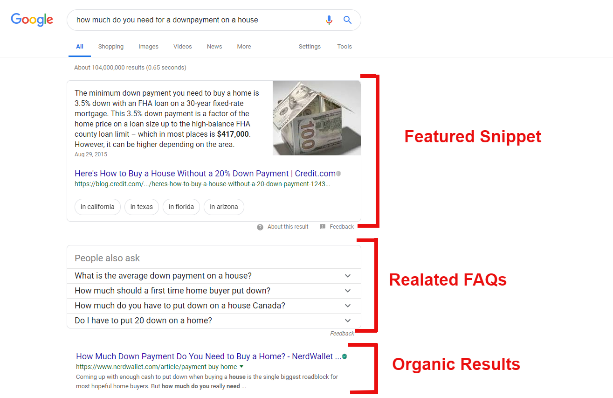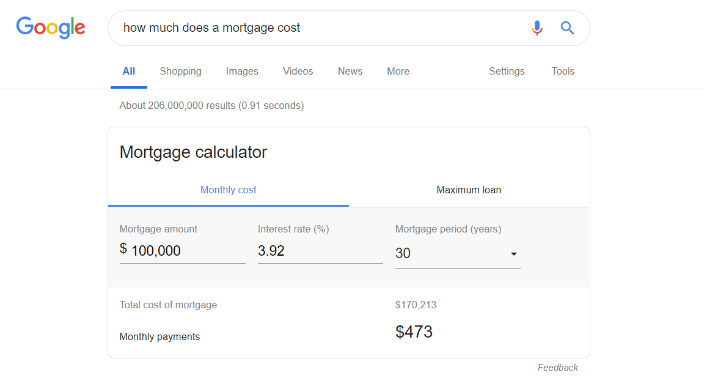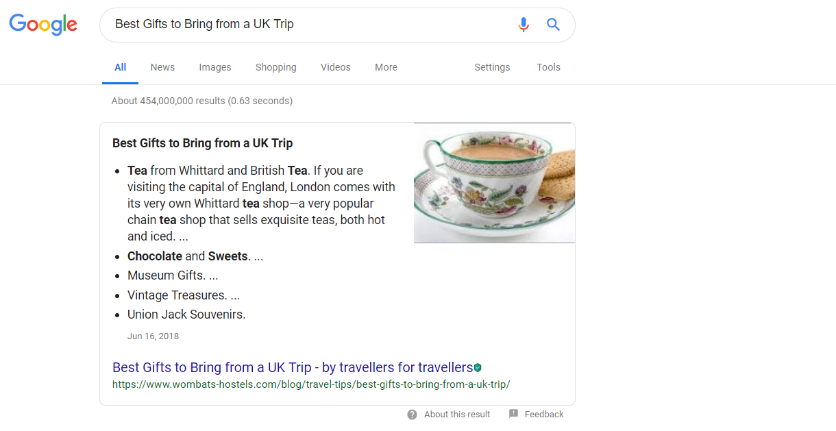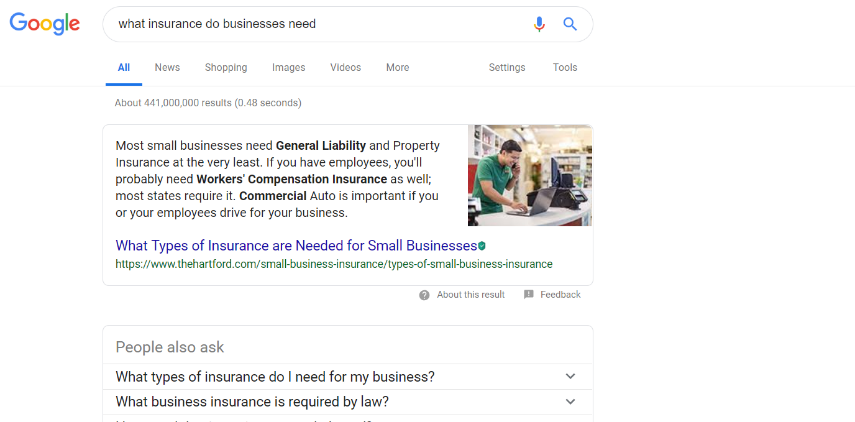Digital Marketing Services
Learn More About Us

Remember the good old days when all Google ever put on its search results pages were clearly-marked advertisements and organic results?
The search engine has changed dramatically since then, evolving from a search engine into a fully-fledged information engine. These days, even the simplest search queries can give you an abundance of widgets, images, videos, and maps.
In fact, Google’s search results can be so thorough you don’t even need to click on a website to get the answer you need. If you ask Google a question about science, history, or even personal finance, chances are, you’ll get the answer you need right in your search results.
Featured snippets are not the same thing as the #1 organic ranking. In fact, the web page that populates the featured snippetA summary of an answer to a user’s query, displayed at the top of Google’s search results. may even be lower than the top several results.
Because of this, some marketers have even questioned if the #1 spot is worth the trouble anymore.
Regardless, featured snippets are a fixture of the Google landscape now. While they’re great for users, they’re not always great for businesses — that is, unless you know how to capture them.
According to Google, they call them featured “snippets” to differentiate them from other listings. In their own words, it’s “because unlike regular web listings, the page’s description — what we call a ‘snippet’ — comes first.”
The purpose of featured snippets is pretty straightforward.
Again, according to Google: “We display featured snippets in search when we believe this format will help people more easily discover what they’re seeking, both from the description and when they click on the link to read the page itself. It’s especially helpful for those on mobile or searching by voice.”
Google insists their featured snippets are not meant to take away from anyone’s web trafficThe number of visitors to a website, often used as a measure of an affiliate's reach and influence., but whether they intend them to or not, they most definitely do.
According to one study, a top organic search result will receive about 26% of all click-throughs when no featured snippet is present. But when a featured snippet is present, the top organic search result gets less than 20% of all click-throughs.
At the time of this study (2017), approximately 12.3% of all search terms were accompanied by a featured snippet.
Let’s say you do a search for “how much do you need for a down payment on a house.” If you look at the example below, it’s easy to see why snippets get so much attention

The snippet dominates the page. Anyone who was just looking for a quick answer may already have it just by reading the snippet. They don’t need to look at the website, and almost everyone else will click-through on the search result featured on the snippet.
Snippets are just the beginning. Google has rolled out numerous other features that will likely keep searchers on Google instead of bringing them to other people’s websites, including the following:
Google even presents tools and interactive features in search results. Still thinking about buying a home? Say hello to Google’s mortgage calculator, which shows up with a search query of “how much does a mortgage cost”:

Basically, a featured snippet is to Google what a centerfold advertisement is to a magazine. You may have a love/hate relationship with Google because of snippets, but don’t kid yourself: You absolutely want to get your website featured on that featured snippet.
Plenty of articles have been written to answer this question.
Getting featured is not easy to do, especially with “how-to” articles and posts that are strictly informational. Google tends to reserve snippets for the Wikipedias and Webster’s Dictionaries of the world, as well as other trustworthy, well-established sources that are immensely popular.
But if you sell products, there is a bit of a hack that can increase your chances of getting a featured snippet. Keep in mind, you must still pay attention to SEO best practices and other ranking factors like domain authority. But if you follow these steps, you’ll have a much better chance of landing a snippet of your own.
Essentially, you must create content that is so immensely helpful to what your customers are looking for that Google can’t help but provide them with a snippet when they search for it. It might be next to impossible to rank for a query like “why is the sky blue,” but if your customers are world travelers, you may be able to rank for a query like, “best gifts to bring from a UK trip.”

Here’s how to do it:
There are two factors you need to consider when thinking about topics: What you sell and what your customers care about. Ideally, your blog topic will closely match what your customers type into Google when doing a search as well as what you have to offerThe specific product or service being promoted by affiliates..
For example, if you sell insurance to businesses, a good topic might be “What Types of Insurance are Needed for Small Businesses?”

Try to keep your keywordsWords or phrases that users type into search engines to find information. as close to the beginning of your title as possible. You may even consider a title like “Small Business Insurance — The Ultimate Guide to What You Need.”
Writing about topics your customers are interested in is something you should be doing already. And that alone won’t win you the featured snippet.
To get listed, you need to structure your blog post so it’s easy for both humans and search engines to understand. If you sell products through your website, you also need to feature your products within the post. Each of your sub-headings should focus on either a category of product you sell or the product itself.
You’ll need enough content for Google to consider your page worthwhile. For this reason, it’s sometimes best to write “ultimate guides” or other types of epic content.
You’ll have several subheadings, and therefore several sections, in your ultimate guide.
Altogether, you should have 1 introduction, a table of contents, multiple sections focused on categories of products you sell (each with 1 sub-section that focuses on a single product you sell), one section that links to an external website featuring something you think is worthwhile but not competitive to you, and one final section that links to related content on your website.
Here’s what the basic structure of your post should look like:
Let’s fill out the structure using the UK gift example from above:
As you can see, each H2 should include the name of your blog post as well as the category of product you’re featuring.
Once you have the structure down, filling in the content is relatively easy. Each H2 section should contain the following:
Your section for related content doesn’t need to be extensive. In fact, a bullet list will work perfectly.
Create hyperlinks to other pages or posts that are related to this one. This helps to tell Google that you cover the topic in-depth and are authoritative on the subject your customer was searching for.
Furthermore, it can help customers find related content they are interested in while also keeping them on your website.
You may be tempted to write the introduction first, but it’s usually easier once you’ve already fleshed out the rest of your post. Your introduction doesn’t need to be very long, but there are a few things it should include:
This is a step that so many people skip because they think it’s irrelevant, but do not skip this step.
Your table of contents helps Google’s crawlers understand your page faster and more easily, which can help you rank better than your competitors. Instead of crawlingThe process by which search engines discover new and updated web pages to index. your entire page, the crawlers know what the page is about immediately based on your table.
Your table of contents should go immediately after your introduction. All your H2 sections should be listed. Each listing in your table should also include an internal hyperlink that goes to its corresponding H2 section.
To create internal hyperlinks, you’ll first need to create anchor textThe clickable text in a hyperlink, important for SEO as it provides context for the linked page.. Anchor text is a small bit of code that you place next to your H2 sections so that your internal hyperlinks know where to bring the user when clicked. Each anchor text should have a unique identifier — it’s usually easiest to just use the name of your H2 section.
In WordPress, you’ll need to switch from “Visual” mode in the top right of your blog post editor to either “Text” or “HTML.”
Find your subsection, then input this code while in “Text” mode:
<a name=”unique-identifier”></a>
So, for the “Teas” section we created above, your anchor text could look like this:
<a name=”teas”>Teas</a> --> Teas
<a name=”teas”>Chocolate</a> --> Chocolates
If you have multiple words in your unique identifier, add a dash between each of the words:
<a name=”big-ben-figurines”></a>
Use dashes in your hyperlinks as well.
When you return to the items in your table of contents, place a “#” and the unique identifiers for each of your anchor texts as the embedded link instead of a URL.
For example, your table may look like the following:
When you click on them, they should take you straight to the H2 section.
Once you’ve built and published your post, submit the URL to Google Search ConsoleA tool by Google that helps monitor and maintain your site's presence in search results.. This is optional, as Google will eventually crawl your page anyway. But there’s no reason to wait.
Simply go to your Google Search Console account, go to “URL inspection,” paste the URL for your published post, and click “Request IndexingThe process of adding web pages into a search engine's database..”
It can take as long as 48 hours for Google to crawl your page. But don’t hesitate to run search queries to see if you rank!
Want to learn how to get quality backlinksLinks from other websites pointing to your website, crucial for SEO., build great content, and master on-page SEOOptimization techniques performed directly on the website, including content and HTML source code.? We’ve got the tools and experience to help you succeed. Sign up for our Los Angeles SEO training course today!
Finally, remember that just because you’ve claimed the featured snippet once, that doesn’t mean you’ll still have it months or years down the road.
Your competitors are uploading new content to their websites all the time. Stay apprised of their strategies and find out if they’re trying to mimic you to take the snippet away. Update your content occasionally, either by adding to it or changing it to keep it relevant.
The hard part is putting up the initial post. Once it’s up, you’ll just need to do a little bit of maintenance to hold on to that featured snippet.
Do you have any other recommendations for claiming a Google featured snippet? What about Google’s knowledge cards and news boxes? Tell us all about it in the comments below and we’ll respond!
If you enjoyed reading this tutorial, you may read our article on How to Get Google Rating Stars in Search Results Using Schema next.
Take your business to the next level and read our new guide: Breadcrumbs & SEO: What They Are & Why They Matter
